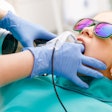People spot a face in the crowd more quickly when teeth are visible -- whether smiling or grimacing -- than a face with a particular facial expression, according to German researchers (Journal of Vision, May 25, 2012, Vol. 12:5, article 7).
The new findings counter the long-held "face-in-the-crowd" effect that suggests only angry-looking faces are detected more readily in a crowd, the researchers noted in a press release.
Research concerning face-in-the-crowd effects essentially deals with how people detect social signals of friendly or unfriendly intent in human faces, said author Gernot Horstmann, PhD, of the Center for Interdisciplinary Research and Department of Psychology at Bielefeld University. But his study shows that detecting smiles or frowns is relatively slow in crowds of neutral faces, whereas toothy grins and snarls are easily detected.
In two studies, the researchers asked subjects to search for a happy or an angry face in a crowd of neutral faces and measured the search speed. While the search was relatively slow when emotion was signaled with a closed-mouth face, the speed search doubled when emotion was signaled with an open mouth and visible teeth. This was the case for both happy and angry faces, and happy faces were found somewhat faster than angry faces.
Inconsistent study results about which of the two expressions are found faster -- happy or angry faces -- suggest that the emotional expression category is not be the only important factor determining the face-in-the-crowd effect.















